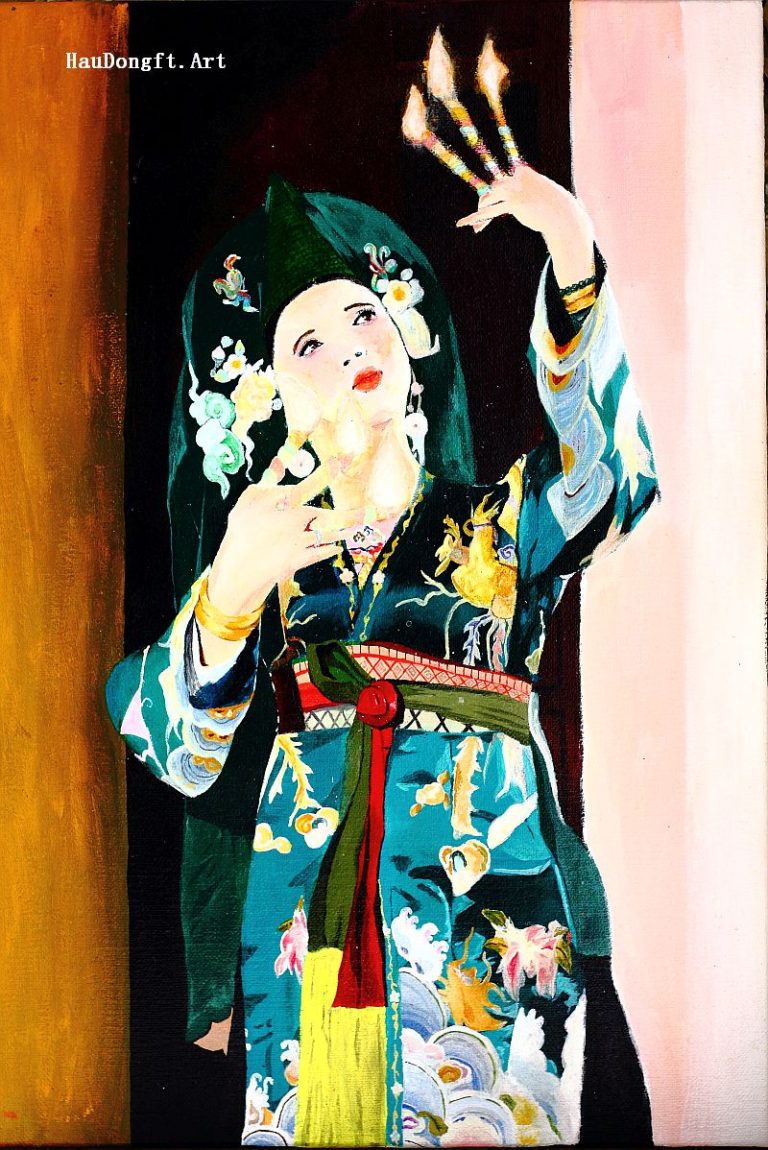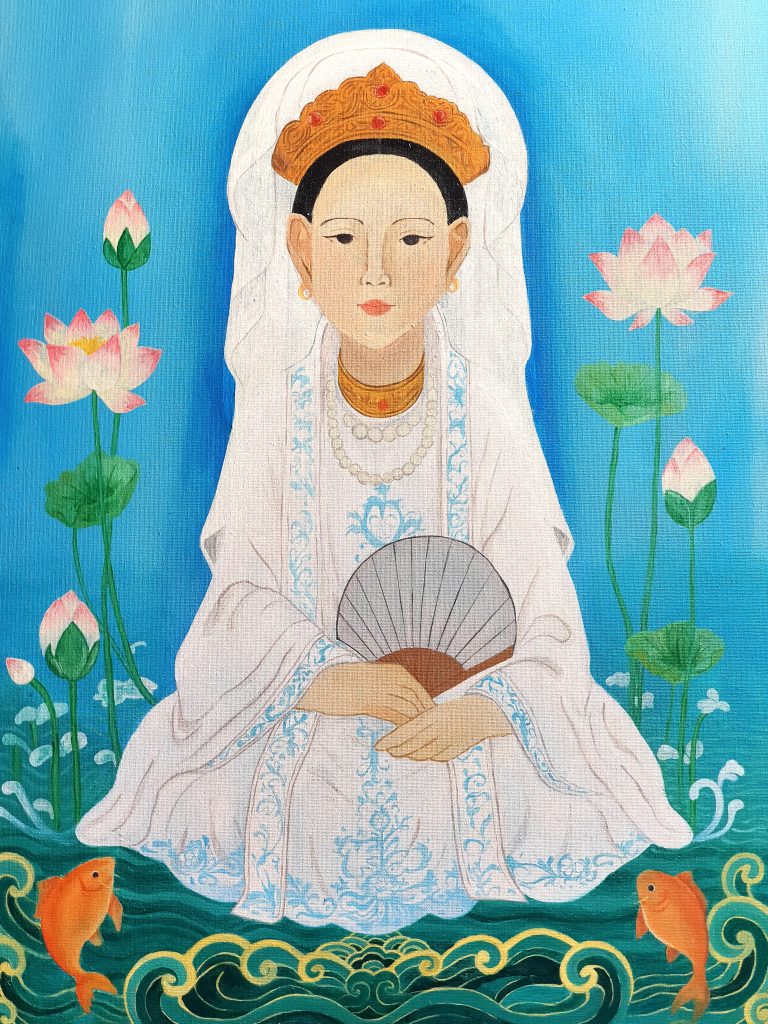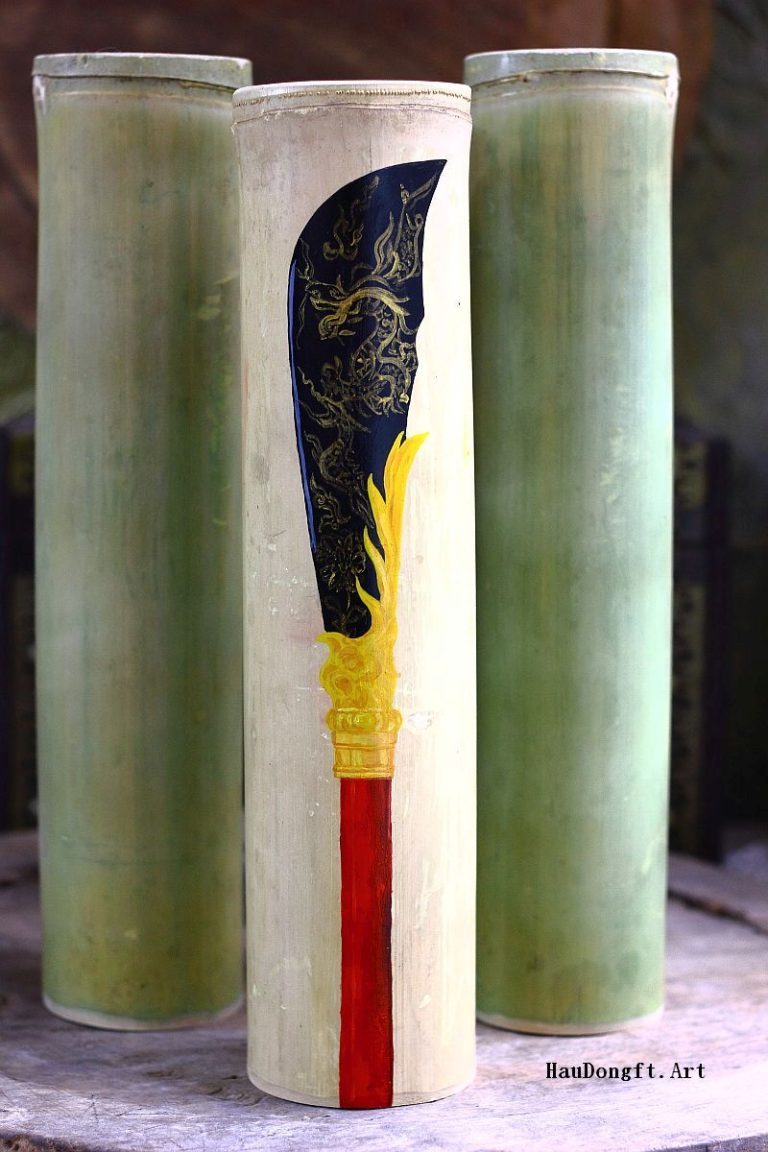
Dance and gesture are the embodied language of hầu đồng. Through subtle hand movements, scarf twirls, fan openings, or sword flourishes, mediums give physical form to the deity’s personality and myth. Gestures also serve as cues for disciples and as vehicles for blessings. This zone allows participants to observe, learn, and practice ritual gestures, understanding them as both aesthetic expressions and psychological embodiments of divine presence.
Participants will:
3. Core Components
a. Close Observation (watching a real-life hầu đồng ritual session at Huong Nghia Temple)
b. Scarf/ Fan/Torch/Weapon dance Practice Corner (at Huan Oanh Academy)
Replicas of ritual props (scarves, fans, flags, swords).
Facilitators or digital tutorials guide participants to practice a short choreography.
c. Blessing Gesture Experience (At Huan Oanh Academy)
Participants are invited to perform or receive common blessing gestures (face veiling ritual, deity’s departure, offering money notes, raising hands in invocation).
d. Dance Circle (At Huan Oanh Academy)
Evaluation & Impact
Outcome
Participants leave with an embodied understanding of hầu đồng as a dance of transformation.
An article contributed to the project as reflection notes
When Movement Becomes Meaning
The main hall of Huan Oanh Academy glowed softly under classic stage light. Scarves and fans were laid neatly on the floor, beside swords polished to a mirror shine. As chầu văn melodies hummed from a nearby speaker, five participants stood in quiet anticipation. Zone 4 of the program – Dance & Gesture – was about to begin.
They had all entered with different expectations: curiosity, skepticism, reverence, or the simple wish to move. Yet by the end of the day, each would leave with a new understanding of what it means to embody culture.
Mai – The Artist Who Found Her Brush in Her Body
Mai, a 19-year-old art student, came to the temple visit hoping to capture good photos. “I wanted composition, contrast, maybe a dramatic shot of incense smoke,” she admitted with a grin. But as she watched the medium twirl a red scarf in slow, spiraling motions, her camera slipped from her hands.
“The scarf looked alive,” she said. “It wasn’t just movement, it breathed.”
Later, when she tried to imitate the gesture, Mai felt her arms soften, her breath fall into rhythm. “The mentor said it represented a water spirit. But for me, it became something else – calmness made visible.”
In her notebook she wrote, “‘The body remembers what the mind can’t describe.” That night, she repainted her unfinished canvas, tracing the memory of those spiraling hands.
Linh – The Volunteer Who Learned to Receive
Linh had assisted mediums for years, handing them fans, pouring tea, arranging offerings. She thought she knew the gestures by heart. But when she practiced the fan movements herself, the delicate openings and sudden closures of the princess dance, she felt an unexpected emotion.
“It was grace,” she said simply. “The kind that comes when your hands forget themselves.”
The act of opening a fan, she explained, made her feel confident, serene, and strangely elevated. During the blessing segment, when she raised her hand toward others, a quiet warmth spread through her chest. “I always thought blessings came from the medium. Now I realized they also return to us.”
She paused, smiled: “The fan doesn’t just cool air; it spreads peace.”
Duy – The Student Who Discovered Stillness in Strength
Duy, a psychology student, approached the sword gesture with skepticism. “I thought it’d be theatrical,” he said, “like pretending to be a warrior.” But once he learned to control the timing – the swing, the pause, the step – his body began to sync with his breath.
“The mentor told us, ‘Power is quiet when it’s real.’ That line stuck.”
As he repeated the sequence, the clang of imagined steel gave way to silence. “It felt like meditation in disguise,” he reflected. “Each movement emptied my thoughts a little more.”
Afterward, he jotted in his journal: “Perhaps hầu đồng gestures are mindfulness practices – rituals that align emotion, breath, and attention.”
Hanh – The Dancer Who Found a New Kind of Stage
For Hanh, a dance teacher, the most profound part was not precision but connection. In the final dance circle, participants stood shoulder to shoulder, scarves fluttering, following the steady pulse of drums.
“At first we stumbled, laughed, lost the rhythm,” she said. “But then, something clicked. We began to breathe together.”
The room shifted ,no longer a workshop, but a living, moving current of rhythm. “It reminded me that healing often happens in synchrony. When bodies align, hearts do too.”
She later wrote on the feedback wall: “The body heals through rhythm. Spirituality isn’t solitary; it’s communal.”
Nam – The Researcher Who Found Knowledge in Motion
Nam had spent a decade documenting hầu đồng rituals, writing papers about symbology and myth. But standing in the practice room, scarf in hand, he realized that books had missed something essential.
“Knowledge isn’t only in the archives,” he said. “It’s in the body – in the muscles that remember.”
He observed how every participant’s gesture differed slightly: one tentative, one fluid, another reverent. “That variance,” he said, “is tradition. It means the form is still alive.”
When the group performed the final blessing, Nam raised his hands too. “I didn’t feel belief,” he said softly, “but I felt recognition as if generations were moving through us.”
A Shared Realization
By sunset, the Academy’s mirrors reflected flushed faces and bright eyes. The participants had come from different worlds — an artist, a volunteer, a student, a dancer, a scholar — yet all shared the same lingering calm.
In Zone 4, dance was not about choreography. It was about discovering what movement does to the mover:
* how a scarf can quiet the mind,
* how a fan can open confidence,
* how a flag can channel focus,
* how rhythm can bind strangers into a brief, breathing unity.
They left understanding that gestures were not mere performance but an embodied language – one that speaks of belief, grace, and the human longing to reach beyond words.
“The moment we began to move,” Mai said as she packed her scarf, “I stopped watching culture and started feeling it.”
Perhaps that is what hầu đồng has always meant — not distant worship, but shared movement: a dance of transformation where heritage enters the body and becomes memory.










© 2025 Hau Dong Featuring Art. All rights reserved. Contact